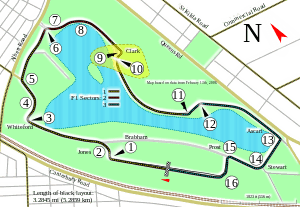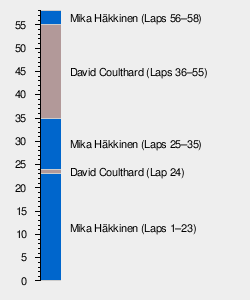1998 Australian Grand Prix
The 1998 Australian Grand Prix was a Formula One motor race held at the Albert Park street circuit in inner Melbourne on 8 March 1998 at 14:00 AEDT (UTC+10). It was the 63rd race in the combined history of the Australian Grand Prix that dates back to the 100 Miles Road Race of 1928. It was the first of the sixteen races of the 1998 FIA Formula One World Championship and held over 58 laps of the 5.3 kilometre street circuit and the sixth to be held on the Albert Park venue first used in 1953, or the third since the new circuit first hosted the race in 1996.
| 1998 Australian Grand Prix | |||
|---|---|---|---|
| Race 1 of 16 in the 1998 Formula One World Championship | |||
 | |||
| Race details | |||
| Date | 8 March 1998 | ||
| Official name | LXIII Qantas Australian Grand Prix | ||
| Location |
Melbourne Grand Prix Circuit Albert Park, Melbourne, Australia | ||
| Course | Albert Park Circuit | ||
| Course length | 5.303 km (3.295 mi) | ||
| Distance | 58 laps, 307.574 km (191.118 mi) | ||
| Weather | Clear with maximum temperatures reaching 24 degrees at the start, increasing to 30 degrees by the end of the race. | ||
| Pole position | |||
| Driver | McLaren-Mercedes | ||
| Time | 1:30.010 | ||
| Fastest lap | |||
| Driver |
| McLaren-Mercedes | |
| Time | 1:31.649 on lap 39 | ||
| Podium | |||
| First | McLaren-Mercedes | ||
| Second | McLaren-Mercedes | ||
| Third | Williams-Mecachrome | ||
|
Lap leaders
| |||
The race was dominated by the McLaren-Mercedes team and won by Mika Häkkinen over his teammate David Coulthard in controversial circumstances. Williams driver Heinz-Harald Frentzen finished third. The race also represented the first win for Japanese tyre manufacturer Bridgestone in Formula One and the first race since the 1991 Canadian Grand Prix not won by Goodyear. Johnny Herbert scored his only point of the season.
Race summary
The McLarens of Mika Häkkinen and David Coulthard made good starts from the front row of the grid, but Ferrari's Michael Schumacher, starting third, also had a good start and tried to overtake second place Coulthard. The Ferrari driver stayed with the McLarens, but retired on lap 6 when his engine failed. This handed third place to the Williams of Jacques Villeneuve, who was being chased by Benetton's Giancarlo Fisichella.
After the first round of pitstops, Villeneuve found himself behind teammate Heinz-Harald Frentzen, Ferrari's Eddie Irvine and Fisichella. Fisichella was able to pass Frentzen for third but then retired with mechanical failure, leaving Frentzen to finish just ahead of Eddie Irvine's Ferrari which had gambled on a one-stop strategy. Villeneuve was lapped soon after this by the McLarens, but he still managed to finish in fifth place.
On lap 36 Häkkinen came into the pits unexpectedly, apparently having misheard a call over the radio. He drove straight through the pitlane and rejoined the race without stopping, but lost first place to teammate Coulthard. In 2007, McLaren boss Ron Dennis claimed that someone had tapped into the team's radio system:[1]
We do not and have not manipulated Grands Prix, unless there were some exceptional circumstances, which occurred in Australia [1998], when someone had tapped into our radio and instructed Mika Häkkinen to enter the pits.
A few laps before the end of the race, Coulthard let Häkkinen past on the front straight. The two had made a pre-race agreement that between the two of them, the driver who led at the first corner would go on to win the race, should he be in the position to do so.[2] David Coulthard and the McLaren team were criticised heavily. The situation surrounding Coulthard allowing Häkkinen through would eventually go to the World Motorsport Council. The verdict was that "any future act prejudicial to the interests of competition should be severely punished in accordance with article 151c of International Sporting Code." "Team orders" continued to be controversial in Formula One and were banned following the events of the 2002 Austrian Grand Prix, but were reallowed following the 2010 German Grand Prix. Frentzen took third place for Williams.[3] The race was the first win for the tyre manufacturer Bridgestone after they entered Formula One a year earlier.[4]
After the race concluded, the Australian Grand Prix Corporation chairman, Ron Walker, lodged an official complaint to the FIA into how the actions of the McLaren team decided the race for Häkkinen.[5]
Classification
Qualifying
Race
- Pedro Diniz's car caught fire on the way to the grid.
Championship standings after the race
|
| |||||||||||||||||||||||||||||||||||||||
- Note: Only the top five positions are included for both sets of standings.
References
- "FIA inquiry into McLaren order". The Daily Telegraph. London. 29 May 2007. Retrieved 21 April 2010.
- "Hakkinen wins Australian Grand Prix decided by pre-race agreement". Associated Press. Archived from the original on 4 June 2011.
- "Hakkinen wins Grand Prix". Gadsden Times. 8 March 1998. p. D6.
- Tremayne, David (9 March 1998). "Coulthard's selfless act of honour". The Independent. London. Retrieved 23 June 2012.
- "Protest lodged over Hakkinen win". BBC News. 9 March 1998. Retrieved 23 June 2012.
- "Australia 1998 - Qualifications • STATS F1". www.statsf1.com. Retrieved 15 October 2018.
- "1998 Australian Grand Prix". formula1.com. Archived from the original on 5 December 2014. Retrieved 24 December 2015.
- "Australia 1998 - Championship • STATS F1". www.statsf1.com. Retrieved 6 March 2019.
| Previous race: 1997 European Grand Prix |
FIA Formula One World Championship 1998 season |
Next race: 1998 Brazilian Grand Prix |
| Previous race: 1997 Australian Grand Prix |
Australian Grand Prix | Next race: 1999 Australian Grand Prix |
